by Harvey Mossman
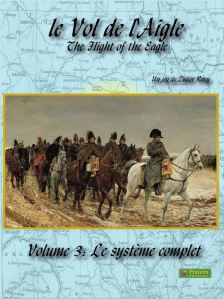 The Flight of the Eagle is a set of rules that harkens back to early days of war gaming when Kreigspiel was done with generals positioned around large maps, pushing little flags or wooden blocks representing the maneuver elements of their army. Umpires would oversee the progress of the campaign and use complex procedures to adjudicate the results of battles. The commanders’ performances would thus be evaluated and a debriefing would follow to determine what went right and what went wrong in the campaign. Designer Didier Rouy and Pratzen Editions have taken this concept and applied it to the Napoleonic era. Using paper, pen, six sided dice and copies of 19th century maps, they have constructed a rule set whereby teams of players can fight almost any of the Napoleonic campaigns from 1805 to 1815 in an umpired setting.
The Flight of the Eagle is a set of rules that harkens back to early days of war gaming when Kreigspiel was done with generals positioned around large maps, pushing little flags or wooden blocks representing the maneuver elements of their army. Umpires would oversee the progress of the campaign and use complex procedures to adjudicate the results of battles. The commanders’ performances would thus be evaluated and a debriefing would follow to determine what went right and what went wrong in the campaign. Designer Didier Rouy and Pratzen Editions have taken this concept and applied it to the Napoleonic era. Using paper, pen, six sided dice and copies of 19th century maps, they have constructed a rule set whereby teams of players can fight almost any of the Napoleonic campaigns from 1805 to 1815 in an umpired setting.
The purpose of Flight of the Eagle is to simulate military events in the Napoleonic era at the campaign scale. The game comes as three volumes, published in 2005, 2008 and finally volume 3 available this year. The rules published in the first volume were meant for campaigns lasting several days such as the Waterloo campaign, the Prussian campaign of 1806 and the 1809 campaign against Austria-Hungary. In these conflicts the decisive battle occurred after just several days of maneuver.
The second volume includes some more advanced rules where campaigns required several months to reach their conclusion. These include the Austerlitz campaign of 1805, Leipzig in 1813 and the retreat from Moscow in 1812. Additional rules include procedures for long-term operations such as supplies, equipment, establishment of depots, foraging, recovery of losses after combat and weather. More complex procedures for combat determination are also provided but completely optional.
Volume 3 was recently released and appears to be the final version tying all of the previous versions into rules that cover the more prolonged campaigns in Spain and Portugal, France 1814 and a complete 1809 Austria campaign that includes the armies that fought in the Italian theater. The third volume includes the rules of the first two volumes as well as a complete set of miniature tactical rules called The Eagle Fights which was previously published separately by Pratzen Editions and is now sold out. There are tables to link both the strategic and tactical system so the players can seamlessly transfer their armies on paper maps to the tabletop. There is also an Army creation module which takes into account Ministry of War functions including conscription, desertion, training, equipment, etc. Finally, diplomatic and political procedures that effect conscription, finances and national economies are included to simulate the effect of public opinion, political events and national morale.
Opening the Box
The box is fairly weighty and contains no less than five booklets including the complete rules set, a complete miniatures game system called The Eagle Fights, a scenario booklet containing 11 different campaigns, a table of organization and equipment for each of the Napoleonic era armies and an Army construction module with proposed rules simulating recruitment and quarter mastering of armies in the Napoleonic era. Additionally there are maps for each campaign scenario as well as a larger map to be utilized with the Army construction rules. Furthermore, there are two high-quality player aid charts, 50 very colorful cardboard unit displays for use with the umpire campaign game and three cardboard unit cut out sheets for the Army construction module and miniatures rules. All the components are of the highest quality. There is no game board per se as the campaigns are fought on the period maps and no dice are included.
The Campaign Begins
“War is a very difficult art; it is often in the campaign that one understands the battle.”
– Napoleon Bonaparte
A good umpire is critical to having a satisfactory campaign. Admittedly he will be burdened with a significant amount of work. He will have to prepare the Army table of organization, assign players to the role of subordinate commanders, keep track of changing unit statistics and move units on the master map. Having experienced this work firsthand, I can tell you that it does require some devotion. However, seeing the campaign unfold from this omniscient viewpoint is truly fascinating and the enjoyment outweighs the drudgery of the extra labor.
To start the campaign, the umpire gives each player a copy of the appropriate 19th century period map for the fight that is about to unfold. These maps are provided in the game and lend great authenticity to the Kreigspiel. Players will need this map to plan out their routes of march and coordinate maneuvers. The game is well-suited to team play with one player being assigned the commander-in-chief and other players taking the role of his subordinate corps commanders. Each commanding officer, other than the commander-in-chief, will be assigned a corps. 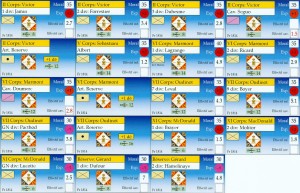 Each corps has several divisions or maneuver elements rated for their infantry and cavalry combat effectives, artillery guns, initial morale ammunition and supplies, and initial fatigue if any. A unit’s Experience is also appended ranging from +2 for the old French Guard down to -2 for recruits that come right out of conscription. These values are provided both in tabular format and on very colorful card displays which can be cut out and used by each Corps commander. Players will need paper and pencil to plan out there March orders for the day and write messages to fellow commanders and their commander-in-chief.
Each corps has several divisions or maneuver elements rated for their infantry and cavalry combat effectives, artillery guns, initial morale ammunition and supplies, and initial fatigue if any. A unit’s Experience is also appended ranging from +2 for the old French Guard down to -2 for recruits that come right out of conscription. These values are provided both in tabular format and on very colorful card displays which can be cut out and used by each Corps commander. Players will need paper and pencil to plan out there March orders for the day and write messages to fellow commanders and their commander-in-chief.
 The game is divided into daily turns which telescope down to smaller hourly increments as the proximity of enemy armies decrease. Each commander will plan out his moves for the day and submit them to the umpire. Units generally move on average approximately 3 km/h although cavalry moves somewhat faster as do headquarters and patrols. Most moves will be over the road net since cross-country movement is slower and likely to result in more fatigue. The commander must determine the Order of March for his divisions, the length of his column and the total number of hours he is marching. He must also designate a destination where his units will stop for the night.
The game is divided into daily turns which telescope down to smaller hourly increments as the proximity of enemy armies decrease. Each commander will plan out his moves for the day and submit them to the umpire. Units generally move on average approximately 3 km/h although cavalry moves somewhat faster as do headquarters and patrols. Most moves will be over the road net since cross-country movement is slower and likely to result in more fatigue. The commander must determine the Order of March for his divisions, the length of his column and the total number of hours he is marching. He must also designate a destination where his units will stop for the night.
At the midnight hour of each day, the umpire is charged with calculating things such as actual distances marched, fatigue generated, supply consumption, etc. These are all handled with the use of simple charts. Simply speaking, the longer you march during the day, the more fatigue you will accumulate. This directly lowers your combat effectives. Marching at night causes increased fatigue penalties. While players are free to Force March, they will quickly find their units becoming combat ineffective due to Fatigue. Fatigue can be recovered if a formation remain stationary and rests for a complete 24 hours.
The umpire plots out each side’s movement on a master map depicting both enemy and friendly forces. He also sends back reports from player patrols and scouts. The umpire must calculate how long it will take for these messages to arrive at the various headquarters and whether these messages are intercepted. If no enemy contact occurs, players simply make plans for the next day and resubmit orders to the umpire.
“The secret of war lies in the communications.”
– Napoleon Bonaparte
Fog of war is paramount since communication between players is strictly limited to written messages and reports dispatched by aid-de-camps. Historically messages were sent via liaison officers riding on horseback. In this game messages travel at a rate of 10 km/h but can be less if bad weather intervenes. There is a die roll that determines whether messages are delayed or even captured. Actionable intelligence is often hours or days out of date due to the time lag resulting from messengers riding great distances on horseback. Players will find they are dealing with extremely fragmentary information as to the enemy’s location, where their own forces might be and what outcome their actions had on the overall campaign. This is absolutely the strongest element of the game conferring extreme challenges and excitement for the participants. Common sense and personal initiative are paramount in directing your forces to a successful conclusion. In short, players feel as if they are actually in the role of a 19th century commander trying to follow orders with incomplete information. This type of angst from fog of war simply cannot be re-created in typical hex and counter board war games.
Resolving Combat
“Death is nothing, but to live defeated and inglorious is to die daily.”
– Napoleon Bonaparte
Once enemy contact occurs, hourly turns rather than daylong turns are performed to allow for the increase action and reaction of the various army maneuver elements. When combat occurs the umpire may utilize one of four combat systems each with increasing complexity and realism. In the standard combat system, units are set up in a battle zone consisting of Center, Right and Left positions. (In the game the right and left sector are noted as East and West sectors but this can be confusing since the orientation of the battle may the north-south rather than east-west. Therefore we prefer the terms Center, Right, and Left). Units in each sector fight their opposite sector. Combat is determined by rolling a number of dice determined by the number of units engaged, the tactical ability of leaders present, the involvement of line or heavy cavalry, the presence of artillery, the presence of elite guard or grenadiers, the comparative strength ratio in combat effectives, terrain features, the strategic value of the overall commander, the presence of neighboring enemy in an adjacent sector, and a variable based on the strategic situation as decided by the umpire. The experience of every unit engaged is added or subtracted to the total number of dice. Combat is resolved by one set of die rolls per sector. The highest total wins the combat for that round with the difference between the sums of each side’s die rolls accounting for the morale loss for the loser. The winner reduces his morale half of this difference rounded down. Each round of combat lasts for two hours and players can redeploy to and from reserve positions at the end of every round.
Morale losses from combat are subtracted from each engaged unit’s morale in a given sector. Once a unit’s morale reaches zero it breaks and retreats from the battle to the rear. Occupying an enemy sector gives bonuses to friendly units in adjacent sectors. Morale in a given sector is also adversely affected for each unit that breaks. In this way, one unit that breaks can cause a chain reaction of routing units.

The combat system is necessarily abstracted. Napoleonic combat was a complex affair requiring intricate choreography of the various combat arms. Players will not be making tactical decisions to coordinate infantry, cavalry and artillery. Nor will they be deciding about formation changes from column to line or square. I found the standard combat system to be one of the weaker points of the game simply because of the high level of abstraction. However, given the operational scale of the game, it does serve to resolve combat quickly and provides fairly realistic results. Players not satisfied with the standard combat system can always try one of the more advanced systems provided (see below) but unless you use the miniatures system to fight battles, you are likely to have some mild dissatisfaction with combat resolution.
“The most dangerous moment comes with victory”
– Napoleon Bonaparte
Combat is over once all units either rout or retreat from the battlefield. Losses in combat effectives are then calculated based on the final morale of units involved in the battle. One point of combat strength is lost for each engaged unit with a final morale of 1-9. Units with a final morale of 10 or higher only take 1/2 point of loss. For every two units that routed, a six sided die is rolled to determine losses. Total combat losses are then distributed across the whole army with every broken unit taking one loss before other engaged units. Broken units will take a second loss before engage units take additional losses and so on. Units with a morale value above zero cannot lose over 29% of their effective strength in a single battle and units with broken morale cannot lose more than 49% of their effectives. One fatigue point per hour fought is added to all units present on the battlefield even if not engaged to represent the stress of battle.
“Without cavalry, battles are without result”
– Napoleon Bonaparte
Pursuit occurs if the battle ends and there is still daylight. The loser retreats by making a two-hour march away from the enemy and then the winner is allowed a two-hour move in pursuit. He inflicts additional losses on the retreating army based on the combat effectives ratio of winning to losing cavalry and the average morale of the pursuer.
The advanced combat system is similar but more detailed than the standard system. It utilizes combat efficacy based on each unit’s level of food and ammunition. Also the die rolls directly inflict losses on the opponent’s morale and combat effectives. The expert combat system requires the individual combat units to deploy on a table and move until they come in contact with the enemy. Contacted groups then fight by rolling sets of six sided dice based on certain modifiers. Finally, the game comes with a complete set of miniatures rules that has been previously published by Pratzen Editions. This is called The Eagles Fight and is quite a detailed miniatures game. For those who enjoy the tactical aspects of Napoleonic era combat, this system is approachable and fun but adds significantly to playing time.
After battles there are simple rules for fatigue and morale recovery. There are even rules for hospitals and when men can return to action. Additionally there are rules for cities, sieges, fortification levels, prisoners of war, weather, escorts and partisans. Players are free to use these rules as desired. None of the individual sections are particularly overwhelming, however players will have to choose the level of realism warranted by their campaign. We found most of these extra rules did not add much to the enjoyment of the game. Nevertheless, the designers provide them for those who relish a higher level of detail.
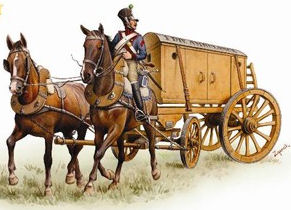 The Proposition for an Army Construction Module allows players to graft on a rather extensive module for management of recruitment and logistics. It encompasses the use of money and budgeting, manpower requirements, development of officers and NCOs, raising of horses, obtaining food, production of muskets, uniforms and other sundry equipment, ammunition procurement and transport. As this is merely a proposed rule set, it is somewhat incomplete yet thought-provoking. The designer include an extensive reference list and this seems to be a first step towards a future volume of the game rather than something that is presently workable in terms of gameplay. Although this component is not fully developed, players can use it should they feel the need to simulate functions that were more in the realm of the Ministry of War. We avoided the extra work in our campaign.
The Proposition for an Army Construction Module allows players to graft on a rather extensive module for management of recruitment and logistics. It encompasses the use of money and budgeting, manpower requirements, development of officers and NCOs, raising of horses, obtaining food, production of muskets, uniforms and other sundry equipment, ammunition procurement and transport. As this is merely a proposed rule set, it is somewhat incomplete yet thought-provoking. The designer include an extensive reference list and this seems to be a first step towards a future volume of the game rather than something that is presently workable in terms of gameplay. Although this component is not fully developed, players can use it should they feel the need to simulate functions that were more in the realm of the Ministry of War. We avoided the extra work in our campaign.
The Dénouement
“Victory belongs to the most persevering.”
– Napoleon Bonaparte
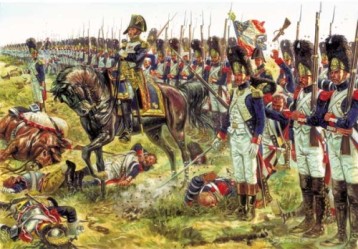 At some point in the campaign, the carnage of shattered bodies, broken caissons and stench of rotting horseflesh will take its toll. One side will achieve its victory conditions and the umpire will call the game. One of the biggest pleasures of this kind of simulation is the debriefing. In The Flight of the Eagle, players pursue their goals with limited intelligence about what has happened in other sectors of the theater of war. The revelation of decisive actions, missed opportunities, leadership indecision and outright incompetence can be quite eye-opening for those who have never played an umpired game. The confidence of armchair generals will be sorely tested when faced with the patchy intelligence and information this type of simulation provides.
At some point in the campaign, the carnage of shattered bodies, broken caissons and stench of rotting horseflesh will take its toll. One side will achieve its victory conditions and the umpire will call the game. One of the biggest pleasures of this kind of simulation is the debriefing. In The Flight of the Eagle, players pursue their goals with limited intelligence about what has happened in other sectors of the theater of war. The revelation of decisive actions, missed opportunities, leadership indecision and outright incompetence can be quite eye-opening for those who have never played an umpired game. The confidence of armchair generals will be sorely tested when faced with the patchy intelligence and information this type of simulation provides.
“Never interrupt your enemy when he is making a mistake.”
– Napoleon Bonaparte
In our Prussian campaign of 1806, the players were absolutely amazed at how their concept of the unfolding campaign diverged from other players and how different their assumptions were from real events. Many players were completely ignorant of actions that were happening nearby their own commands. They were astonished how simple messages could be misinterpreted because of fragmentary intelligence. In one instance, a captured French message was believed to be a “plant” by the enemy resulting in a missed opportunity for decisive action by the Prussians! Players who were customarily bold when playing hex and counter war games became cautious and timid when faced with incomplete knowledge of the battlefield. Others became recklessly bold. It was these reactions that made the game so enjoyable
Fini
“If the art of war were nothing but the art of avoiding risks, glory would become the prey of mediocre minds. I have made all the calculations, fate will do the rest.”
– Napoleon Bonaparte
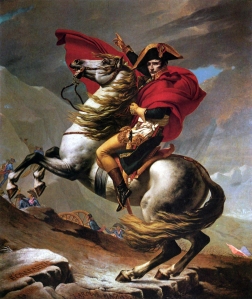 The Flight of the Eagle is not an all-encompassing rule set. While fairly comprehensive, it requires the umpire to adjudicate situations that may not be completely covered in the rules. This does not detract from the overall experience. The rules are well researched though simplifications were necessarily made to cover all the exigencies of Napoleonic era combat. While detailed, the players not bogged down in minutia. The game is played at an operational level requiring adept movement of divisions and corps, not individual battalions or regiments. There are no significant rules for formations such as column, line or square. Players will not be ordering cavalry charges or massing artillery batteries unless they choose to use the included miniature rules. If you are interested in the tactics of Napoleonic warfare, this is not the game for you. Nevertheless, I feel the game achieves its stated design intent to provide players with a realistic simulation of military events of the Napoleonic era at the campaign scale. It is a vastly different experience playing The Flight of the Eagle compared to the hex and counter board games. It will definitely open your eyes to the limitations of the usual games we play that give unrealistic knowledge of the enemy strengths and movements. The Flight of the Eagle provokes player anxiety dealing with fragmentary intelligence and the time/space dilemma of 19th century communications. Players are forced to problem solve with incomplete knowledge of their own forces and of the enemy. Very few games provide this type of realistic fog of war. Perhaps The Flight of the Eagle will inspire you to pick up a marshal’s baton, mount your horse and lead men into the uncertainty of war.
The Flight of the Eagle is not an all-encompassing rule set. While fairly comprehensive, it requires the umpire to adjudicate situations that may not be completely covered in the rules. This does not detract from the overall experience. The rules are well researched though simplifications were necessarily made to cover all the exigencies of Napoleonic era combat. While detailed, the players not bogged down in minutia. The game is played at an operational level requiring adept movement of divisions and corps, not individual battalions or regiments. There are no significant rules for formations such as column, line or square. Players will not be ordering cavalry charges or massing artillery batteries unless they choose to use the included miniature rules. If you are interested in the tactics of Napoleonic warfare, this is not the game for you. Nevertheless, I feel the game achieves its stated design intent to provide players with a realistic simulation of military events of the Napoleonic era at the campaign scale. It is a vastly different experience playing The Flight of the Eagle compared to the hex and counter board games. It will definitely open your eyes to the limitations of the usual games we play that give unrealistic knowledge of the enemy strengths and movements. The Flight of the Eagle provokes player anxiety dealing with fragmentary intelligence and the time/space dilemma of 19th century communications. Players are forced to problem solve with incomplete knowledge of their own forces and of the enemy. Very few games provide this type of realistic fog of war. Perhaps The Flight of the Eagle will inspire you to pick up a marshal’s baton, mount your horse and lead men into the uncertainty of war.

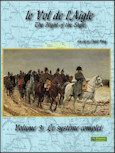


Harvey,
Thank you for this fantastic review. I am so glad you enjoyed beeing the Umpire as I enjoyed it in the 25+ campaigns I played so far.
One comment though, we chose “east, center, west” because of some confusion when we used “right, center left”, as one player’s left is of course the ohter player’s right ! But if you did not have any confusion, your choice is perfectly fine.
We added on our website to after-action-reports as a good illustration :
http://didier-rouy.webs.com/levoldelaigle.htm
The report on the Salamanca campaign can be downloaded there too. I am loking forward to your campaign “chronicles”.
Didier Rouy
Recently umpired a 1809 Danube campaign for 8 players. We played off an on for one year representing 16th April 1809 to 3rd May 1809.
1 player played Nap with the IGC and VII Corps and III Corps reserve Rouyer
1 player played IV Corps
1player played VIII Corps and IX Corps
1player played Army of Italy under Eugene
1player played Archduke Charles with 1 and II Corps and I Reserve Corps
1plyer played III and IV Corps
1player played V and VI Corps and II Reserve Corps
1player played Army in Italy under Archduke John
we had 3 major battles in northern theatre(Munich,Austrian win,Phaffenhofen French win and Siegensburg French win
Two in Italy Pizano TAgliamento AUstrian win and Trisesimo nr Udine French win.
Players generally found the fog of war difficult to handle and we’re not sure o their troop strengths.
Overall I believe this is the best NAp game I have played.
Kind regards
Jim
Great review. I’m looking forward to the play through.
The Play through campaign after action report is now available on The BoardGamingLife
Wonderful review! Have had my eyes on this game for some time and this text pushed me over the proverbial edge. Cheers